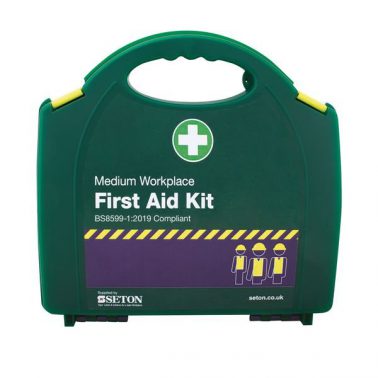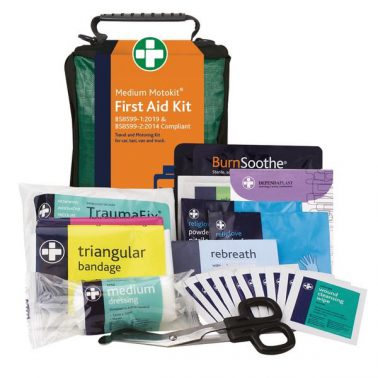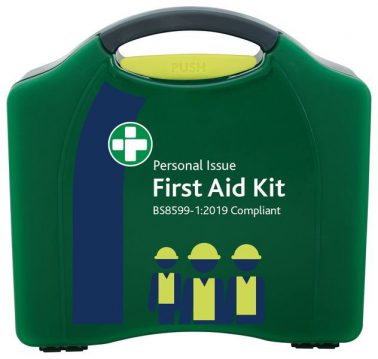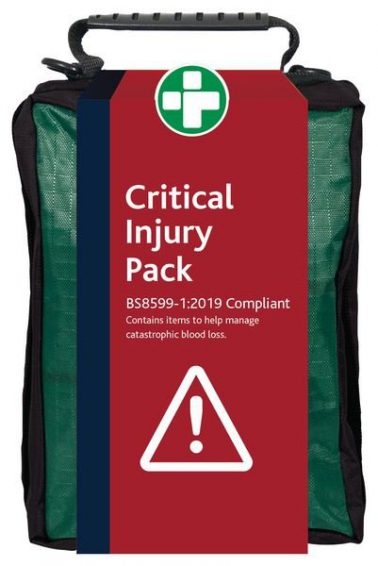Changes to workplace first aid kits
 Although guidelines were initially introduced with the aim of simplifying and consolidating the regulatory requirements that employers have in respect of their obligations to provide access to first aid kits, the waters have become somewhat muddied over the last number of years. To this end, the British Healthcare Trades Association (BHTA) convened a working group to review these standards as part of a constant improvement process. Although first convened in May 2015, the conclusions of this process are only just coming into effect as of January 2019, and this latest update significantly expands the previous BS 8599-1 Workplace First Aid Kits (2011) standards. The 2011 standard will be phased out over the next 6 to 12 months and will be fully replaced by the most recent update, known as BS 8599-1:2019.
Although guidelines were initially introduced with the aim of simplifying and consolidating the regulatory requirements that employers have in respect of their obligations to provide access to first aid kits, the waters have become somewhat muddied over the last number of years. To this end, the British Healthcare Trades Association (BHTA) convened a working group to review these standards as part of a constant improvement process. Although first convened in May 2015, the conclusions of this process are only just coming into effect as of January 2019, and this latest update significantly expands the previous BS 8599-1 Workplace First Aid Kits (2011) standards. The 2011 standard will be phased out over the next 6 to 12 months and will be fully replaced by the most recent update, known as BS 8599-1:2019.
This newer standard represents a substantial update to the previous requirements, and while not a complete overhaul, does change things enough to warrant a reassessment of your current workplace first aid kits. In particular, the British Standards Institute (BSI) have set out updates to a number of kits to meet these new standards, including workplace first aid kits and vehicle first aid kits. In addition, the BSI have also introduced two specific new kits to cater for incidents in particular circumstances: the personal issue first aid kit and the critical injury first aid kit. In addition to detailed component requirements, the new standard sets out requirements for the container holding the kit. The updated standard also contains tables listing what should be contained in a workplace first aid kit, as well as a guide on the appropriate size of the kit depending on the type of environment in which it is used.
Please read below for a concise overview of these new and updated workplace first aid kits, along with some advice on how these updates might affect you.
 What’s changed? Contents for workplace kits
What’s changed? Contents for workplace kits
Although the old standard (BS 8599-1:2011) will still be operational over the course of a 12-month transition period to allow employers to make the change, it is best to familiarise yourself with all the changes and to get your business up to specification as soon as possible.
One of the most immediately obvious changes relates to the updated size standards that are included in BS 8599-1:2019. These standards also amended the recommended quantities for workplace first aid kits and designate three size categories in this regard. The main changes are as follows:
- Small workplace first aid kit: 2 medium 12 x 12cm dressings (decreased from 4), 2 large 18 x 18cm dressings (increased from 1), and safety pins are no longer required, as they are replaced with microporous tape.
- Medium workplace first aid kit: 4 medium 12 x 12cm dressings (decreased from 6), 3 large 18 x 18cm dressings (increased from 2), 2 rolls of microporous tape (increased from 1), and safety pins are no longer required.
- Large workplace first aid kit: 6 medium 12 x 12cm dressings (decreased from 8), 4 large 18 x 18cm dressings (increased from 2), 3 rolls of microporous tape (increased from 1), and safety pins are no longer required.
The standard also restates how many first aid kits will be required for the number of people in a given workplace. In addition, it is important to note that the standard states that where there are special circumstances in a particular workplace, such as remoteness from emergency services, the quantity of first aid kits should be increased as needed. As such, the following list should not be taken as authoritative and your individual needs should be carefully assessed.
For low hazard workplaces the requirements are:
- Fewer than 25 employees: 1 small workplace first aid kit.
- From 25-100 employees: 1 medium workplace first aid kit.
- Over 100 employees: 1 large workplace first aid kit per 100 employees.
For high hazard work environments, the requirements are slightly more stringent:
- Fewer than five employees: 1 small first workplace first aid kit
- From 5-25 employees: 1 medium workplace first aid kit
- More than 25 employees: 1 large kit per 25 employees
 Travel and motoring first aid kit
Travel and motoring first aid kit
Another noteworthy update in the BS 8599-:2019 guidelines relates to what was previously the ‘Travel first aid kit’. This has been replaced in the revised 2019 guidelines with a ‘Travel and motoring first aid kit’. This change represents a significant overhaul of the 2011 guidelines and looks to match the recommendations from the Medium BS 8599-2-compliant vehicle and motoring first aid kit.
Travel and motoring first aid kits should be installed in all company vehicles and are designed to be transportable and used when employees are working away from the main workplace. For cars, vans, and lorries BS 8599-2:2019 guidelines recommend a medium size that contains the following (Note: The equipment list requirements for motorcycles, minibuses and coaches are different):
1 x guidance leaflet.
- 1 x contents list.
- 1 x medium sterile dressing.
- 1 x triangular bandage.
- 10 x sterile adhesive dressings.
- 10 x alcohol-free cleansing wipes.
- 2 x pairs of nitrile gloves.
- 1 x face shield.
- 1 x foil blanket.
- 2 x burn dressings.
- 1 x universal shears.
- 1 x adhesive dressing.
- 1 x medium trauma dressing.
In the BS 8599-1:2019 updated guidelines, a personal issue first aid kit has been introduced, aimed specifically at lone workers. This kit is designed specifically for the needs of those engaged in work activities away from the main workplace, such as those doing ground, security or maintenance work, or cleaning personnel. They are intended as a supplementary resource to small, medium and large first aid kits being available in the workplace they are separated from. Their contents should be as follows:
- 1 x guidance leaflet.
- 1 x contents list.
- 1 x large sterile dressing.
- 1 x triangular bandage.
- 10 x sterile adhesive dressings.
- 4 x alcohol-free cleansing wipes.
- 2 x pairs of nitrile gloves.
- 1 x face shield.
- 1 x foil blanket.
- 1 x universal shears.
One of the most notable additions in this update, and one very much reflective of the times we live in, is the critical injury first aid kit. The updated standard recommends a critical injury first aid kit where employees will be engaged in work with “dangerous machinery or sharp instruments, cutting equipment, power tools, construction, agriculture, forestry, etc.” According to the guidelines, employers should undertake a risk assessment and store appropriate numbers of the critical injury first aid kit in line with the level of risk and the number of employees on site at any given time. Interestingly, the guidelines relating to the critical injury first aid kit also make reference to the need to assess whether you should have access to kits for use in the event of acts of terrorism or any other mass casualty incident.
In terms of the contents of the critical injury first aid kit, of note are the requirements for trauma dressings, haemostatic dressings and a tourniquet. These additions were recommended by the European Resuscitation Council. Critical injury first aid kits will also need to include:
- 1 x guidance leaflet.
- 1 x contents label.
- 2 x pairs nitrile gloves.
- 2 x large trauma dressings 15 x 18cm.
- 2 x haemostatic dressings.
- 1 x tourniquet.
- 1 x foil blanket.
- 1 x heavy-duty shears.
How it affects you
It should first be stated that this new and updated standard is not strictly relevant to every individual required to carry a first aid kit. However, it will be of importance and interest to the following industries and individuals in particular:
- Manufacturers of first aid kits.
- Occupational health and safety representatives compiling workplace first aid kits.
- Anyone in a workplace environment with responsibility for occupational safety, such as health and safety officers, human resource managers, office managers, operations managers or managers at any level.
Generally speaking, most existing British Standard first aid kits designed to meet the old standard will be adequate for the time being. However, the transition period only lasts so long and once it is up, you will be required to be compliant with the new standard. As such, it’s best to get a head start today. The differences with the updated standard are significant enough that a needs assessment should be undertaken and your stock updated as necessary.
Overall, the BS 8599-1:2019 standard is a most welcome update and significantly clarifies the health and safety obligations in respect of workplace first aid kits. The 2019 update provides much needed detail and specific guidance, which allows business owners and concerned managers to begin building a suitable workplace first aid kit. Once fully in effect, this new regime will promote employer and employee safety and greatly assist first aiders and emergency first responders in providing treatment when and where it is most needed. If you take workplace health and safety seriously, it is vital that you familiarise yourself with these updated requirements and acquire a workplace first aid kit that meets the standards.
There is more information and suggested kit contents in our article about first aid in the office environment.


